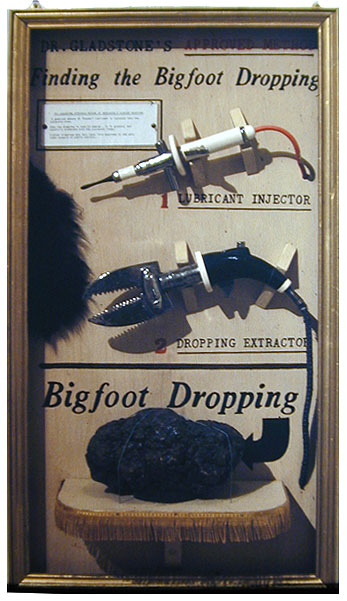
June 11, 2007

Blake Mathys has been a Bigfoot researcher for decades, from his days of being in the woods of the Midwest, investigating as a kid growing up in Ohio. Currently, he is studying for his Ph. D. in wildlife biology. As I write this, he is presently on his sixth trip to Bermuda, collecting further data on the native birds from that island for his dissertation.
Blake Mathys shares his following “Six Rules of Bigfoot Research” for feedback and critiques.
Six Rules of Bigfoot Research
The following “Six Rules of Bigfoot Research” are meant to improve the quality of the evidence that is gathered. Similar rules could be applied to any cryptozoological research and are indeed just extensions of healthy skepticism.
1. Physical evidence (broken branches, moved rocks, stick formations, et cetera) that could have been caused by humans or known animals should not be regarded as Bigfoot-related.
2. Sounds that are heard without seeing the creature responsible cannot be directly linked to Bigfoot. While it may be necessary to suspend this rule during the course of an investigation, it must be imposed if no corroborating evidence is discovered.
3. It is not possible to reliably determine if people are lying simply by listening to their testimony.
4. Despite the real possibility of getting shot, people do walk around in gorilla outfits.
5. Most people are incredibly bad at judging heights, weights, and distances. If a witness did not have something in close proximity with which to compare height, estimates are likely to be inaccurate. This does not reflect on credibility, it is simply a common human attribute.
6. Despite no obvious monetary gain or fame, people will invent Bigfoot sightings to gain attention. This is true even if the attention is only from a few Bigfoot researchers.
Another rule that didn’t quite make the list is “There are no caves.” In Ohio, many Bigfoot witnesses will mention nearby caves as possible living areas for the creatures. These caves don’t exist. There may be rock overhangs, but do not bother looking for actual caves. I’m not sure if this rule applies in other areas. (I know that there are actual caves in Ohio, but it has been my experience that searching for alleged Bigfoot-related caves is never successful.)by Blake Mathys
I appreciate thoughtful work and feel Blake stands on firm to semi-firm ground on most of his points. (I reserve mild disagreement on #3, based on my experiences, for sometimes it is possible for a good and skilled interviewer to detect deception during extended and multiple interviews of the same eyewitness.)
But if we consider Blake’s afterthought about his possible “#7,” his “no cave” addition would be without foundation. Absolutes are usually a mistake, anyway, and for Blake to say “searching for alleged Bigfoot-related caves is never successful” is incorrect.
“Never”? Perhaps this has more to do with a breakdown in definitions. Usually, underground caves are formally termed “caverns,” and found most often in limestone. Therefore, specifically “caverns” are few and far-between in Ohio. In the Buckeye State, when people say “caves,” as Blake is partially conveying, the caves of Ohio are most often recess caves or overhangs, caused by erosion in sandstone. Are there “caves” in Ohio? Well, yes, as the largest recess cave in the state is part of the state park system, and called “Ash Cave” at Hocking Hills State Park.
Other “named” caves or caverns in Ohio, include: Haunted Cave, Heineman Winery-Crystal Cave, Olentangy Indian Caverns, Perry’s Cave, Saltpeter Caves, Seneca Caverns, The 7 Caves, Zane Caverns, and Ohio Caverns. For more details on all of these locations, click here.
Are some of these caves “Bigfoot-related”? Just as much as someone’s farm, a near-by creek, or a road near where a Bigfoot is sighted can be “Bigfoot-related.”
Also, throughout North America, limestone caverns, sandstone rock outcroppings, old abandoned shacks, rundown unoccupied camps, empty barns, and all kinds of presumed habitat are found by Bigfoot hunters and linked to thoughts of a migrating Bigfoot or free-ranging Sasquatch. It doesn’t mean those structures have been used or that unknown hairy hominoids exist, but that caves can be found, even in Ohio, with histories of Bigfoot activity near them is a fact and not a negative absolute.
The illustration at top is a Bigfoot dropping gaff sold by ClaytonBaily.com/ceramics/.
About Loren Coleman
Loren Coleman is one of the world’s leading cryptozoologists, some say “the” leading living cryptozoologist. Certainly, he is acknowledged as the current living American researcher and writer who has most popularized cryptozoology in the late 20th and early 21st centuries.
Starting his fieldwork and investigations in 1960, after traveling and trekking extensively in pursuit of cryptozoological mysteries, Coleman began writing to share his experiences in 1969. An honorary member of Ivan T. Sanderson’s Society for the Investigation of the Unexplained in the 1970s, Coleman has been bestowed with similar honorary memberships of the North Idaho College Cryptozoology Club in 1983, and in subsequent years, that of the British Columbia Scientific Cryptozoology Club, CryptoSafari International, and other international organizations. He was also a Life Member and Benefactor of the International Society of Cryptozoology (now-defunct).
Loren Coleman’s daily blog, as a member of the Cryptomundo Team, served as an ongoing avenue of communication for the ever-growing body of cryptozoo news from 2005 through 2013. He returned as an infrequent contributor beginning Halloween week of 2015.
Coleman is the founder in 2003, and current director of the International Cryptozoology Museum in Portland, Maine.
Filed under Bigfoot, Cryptotourism, CryptoZoo News, Cryptozoologists, Cryptozoology, Evidence, Expedition Reports, Eyewitness Accounts, Forensic Science, Hoaxes, Sasquatch